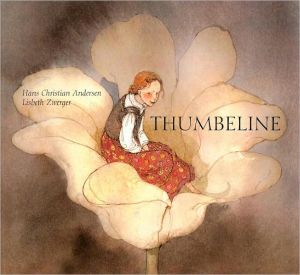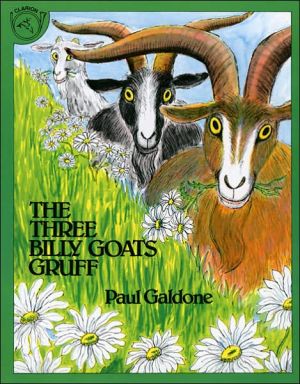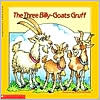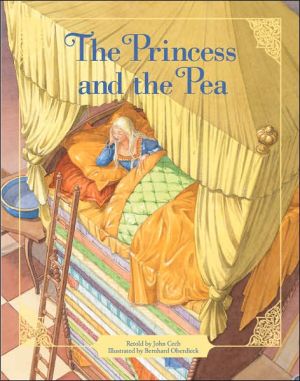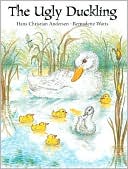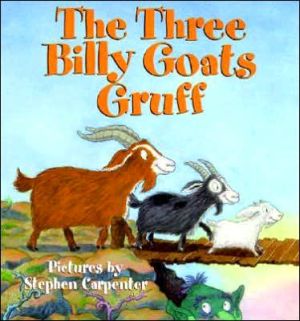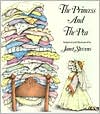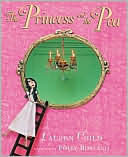Thumbeline
Once upon a time there was a woman who was sad because she had no children. One day she planted a magic seed and from the seed grew a flower. Inside the flower was a tiny, exquisite girl no bigger than the woman's thumb. Her name was Thumbelina.\ \ The two lived happily together until an ugly old toad snuck in and snatched Thumbelina away. So began Thumbelina's adventures in a world full of dangers for little people. Luckily, size isn't all that matters, and Thumbelina's kindness and courage...
Search in google:
Among one of Andersen's very earliest stories, "Thumbeline" has been enchantingly illustrated by an internationally acclaimed artist who perfectly captures Thumbeline's charming world with all its dangers and delights. Full color.Publishers WeeklyTwo-time Caldecott Honor artist Pinkney (The Faithful Friend; Duke Ellington) presents a visually snappy adaptation of this Hans Christian Andersen tale. Rendered in colored inks on clay board, the wispy art accentuates the natural setting among pond reeds and flower stalks, and features a sunny palette punctuated by electric hues. This Thumbelina, a black child who springs from a gold and flame-red blossom, spends her days floating on a tulip petal, "rowing on a little lake that was really a bowl of water decorated with flowers." In a rather choppy narrative, the author chronicles the tiny heroine's adventures after she is kidnapped by a toad (who sports a gaily patterned kerchief and has spectacles perched on her nose). Pinkney whimsically depicts the animal friends who in turn help Thumbelina escape from her captors, offer her shelter and whisk her away from the mole fianc she does not love into the arms of the dashing, equally diminutive king of the flower people. Despite some stilted prose (e.g., "Thumbelina was glad to agree"), the imaginative illustrations gives this chestnut a fresh look. Ages 4-up. (Sept.) Copyright 2003 Reed Business Information.
Once upon a time there was a woman whose only desire was to have a tiny little child. Now she had no idea where she could get one, so she went to an old witch and asked her: "Please, could you tell me where I could get a tiny little child? I would so love to have one."\ \ "That is not so difficult," said the witch. "Here is a grain of barley; it is not the kind that grows in the farmer's fields or that you can feed to the chickens. Plant it in a flowerpot and watch what happens."\ \ \ \ Excerpted from Thumbelina by Hans Christian Andersen. Translation copyright (c) 1974 by Erik Haugaard. Illustrations copyright (c) 1996 by Arlene Graston. Excerpted by permission of Delacorte Press, a division of the Bantam Doubleday Dell Publishing Group, Inc. All rights reserved. No part of this excerpt may be reproduced or reprinted without permission in writing from the publisher.\ \
\ Publishers WeeklyTwo-time Caldecott Honor artist Pinkney (The Faithful Friend; Duke Ellington) presents a visually snappy adaptation of this Hans Christian Andersen tale. Rendered in colored inks on clay board, the wispy art accentuates the natural setting among pond reeds and flower stalks, and features a sunny palette punctuated by electric hues. This Thumbelina, a black child who springs from a gold and flame-red blossom, spends her days floating on a tulip petal, "rowing on a little lake that was really a bowl of water decorated with flowers." In a rather choppy narrative, the author chronicles the tiny heroine's adventures after she is kidnapped by a toad (who sports a gaily patterned kerchief and has spectacles perched on her nose). Pinkney whimsically depicts the animal friends who in turn help Thumbelina escape from her captors, offer her shelter and whisk her away from the mole fianc she does not love into the arms of the dashing, equally diminutive king of the flower people. Despite some stilted prose (e.g., "Thumbelina was glad to agree"), the imaginative illustrations gives this chestnut a fresh look. Ages 4-up. (Sept.) Copyright 2003 Reed Business Information.\ \ \ \ \ Children's LiteratureThumbelina enjoys rowing her tulip petal boat in a bowl of water and sleeping in a polished walnut shell. But one night while she is sleeping a toad steals her away with the intent of having her for a daughter-in-law. Thumbelina escapes that fate with the help of some fish and a butterfly, only to find herself lost in the woods. A kindly field mouse takes her in when winter arrives and then begins planning for Thumbelina to marry her neighbor, the mole. A bird that Thumbelina has befriended saves her just in time and flies her to a beautiful field of flowers. The flower people welcome her and the flower king asks her to be his bride. Charming, full-color illustrations fill the pages. Thumbelina's small size is accentuated as she is shown tiny and dainty next the frog, the mouse, and the mole. These lovely illustrations bring new life to this familiar tale. 2003, Greenwillow Books, Ages 6 to 11. \ — Phyllis Kennemer, Ph.D.\ \ \ Children's Literature\ - Children's Literature\ This is a sweet and gentle retelling of Hans Christian Andersen's well-known tale of a thumb size young girl who appears magically in a flower. In her adventures she is captured by a mother toad, a June bug, and survives the winter by staying with a field mouse. Finally, she is delivered from marrying a grumpy mole by a cheerful sparrow and transported to happiness in the kingdom of flowers. The pastel-toned pictures complement this retelling, however it lacks excitement and Thumbeline desperately needs some gumption. In an age where girls are encouraged to be creative, energetic and intelligent in order to reach their goals, Thumbeline is a bland role model. Previously released in 1980 in Switzerland, this retelling would make a good calm bedtime story. Librarians may want to add this to their collection, if only to compare it with other versions of this familiar fairy tale. 2000, (orig. 1980), North-South Books, Ages 5 to 10, $15.95. Reviewer: Wendy Pollock-Gilson—Children's Literature\ \ \ \ \ Children's Literature\ - Deborah Zink Roffino\ Hans Christian Anderson's poignant tale of a tiny girl kidnapped and trapped in the woods is retold here, flushed with violet-hued watercolors. Dizzying perspectives magnify wee Thumbelina's travails in the enormous world around her. Descriptive language breathes life into the adventures as she escapes her many captors and finally meets a whole society of folks her size.\ \ \ \ \ Children's Literature\ - Mary Quattlebaum\ The idea of teeny-tiny people enchanted me as a kid and I loved reading about Thumbelina, the girl who sprouted in a flowerpot and had to brave the huge, dangerous world before finding happiness with others her size. Erik Haugaard's unabridged translation of Hans Christian Anderson's Thumbelina captures the magical, musical quality of the original, with Arlene Graston's pastel-hued illustrations a lovely accompaniment.\ \ \ \ \ School Library JournalPreS-Gr 2-This greatly abridged retelling joins many versions in recent years, both single volumes and in collections of Andersen's work. It is told in simplified language and vocabulary, minimizing many of the darker elements of the tale. Unfortunately, it begins rather abruptly and some of the emotional content is lessened. Pinkney uses colored inks on clay board to illustrate the story with vibrant colors, large shapes, and sketch-type outlines. The artwork, while certainly bold and engaging, does not meld well with the delicate and fragile nature of the original story. Still, since it is so visually different from other retellings, comparison among them would be an interesting student activity. The book's format is large and would work well for group sharing.-Cris Riedel, Ellis B. Hyde Elementary School, Dansville, NY Copyright 2003 Reed Business Information.\ \ \ \ \ Kirkus ReviewsMinor details and most of Andersen's literary flourishes have been cut out of this shortened version, but the essential plot is intact. Grown from a magic seed, Thumbelina is repeatedly kidnapped for her beauty, escapes two forced-marriage attempts with the help of animal friends, and finally consents to wed the king of the flower people, because "he was the right husband for her." Pinkney places his tall (about three inches-or triple her size in the original), graceful, cinnamon-skinned figure within close-up natural landscapes, vibrantly depicted in warm browns and golds with short, thick, curving brushstrokes. Though Thumbelina is not the most active or independent-minded of role models, she does have plenty of adventures, and the sense of self-possession that she radiates in every scene is never shaken by events. And even though her eye makeup looks like it was laid on with a trowel, the preciousness that tends to infect other renditions of the tale is less evident in this readable adaptation. (Picture book/fairy tale. 8-10)\ \
